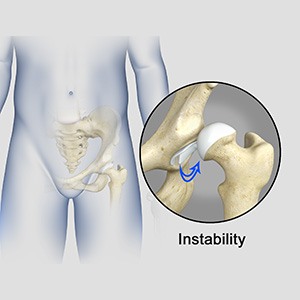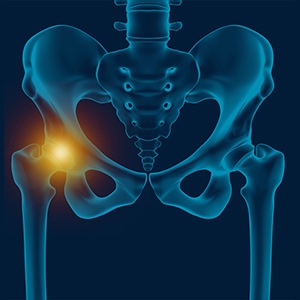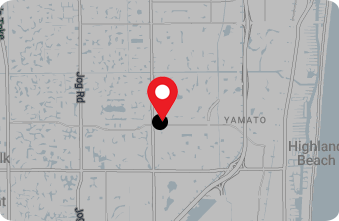- Hip Anatomy
- Hip Conditions
- Hip Procedures
Osteoarthritis of the Hip

Osteoarthritis, also called degenerative joint disease, is the most common form of arthritis. It occurs most often in the elderly. This disease affects the tissue covering the ends of bones in a joint called cartilage. In osteoarthritis, the cartilage becomes damaged and worn out, causing pain, swelling, stiffness...
Inflammatory Arthritis of the Hip

The inflammation of the joints is referred to as arthritis. Inflammation arises when the smooth lining called cartilage at the ends of bones wears away. In some cases, the inflammation is caused when the lining of the joint becomes inflamed as part of an underlying systemic disease. These conditions are referred to as inflammatory arthritis.
Hip Injury

The hip joint is one of the most important and flexible joints in the human body which allows us to walk, run, bend and perform physical activities. It is a ball (femoral head) and socket joint formed between the hip bone and femur (thighbone). It is surrounded by strong muscles and tough ligaments that prevent its dislocation.
Hip Ligament Injuries

Injuries to the hip ligaments are commonly called a hip sprain and can range from minor tears of the ligaments to more serious injuries involving the hip muscles, tendons or bone. The hip joint is a ball and socket joint; the ball being the head of the femur (thigh bone) and the socket is the acetabulum of the pelvis.
Hip Fracture

The hip joint is a “ball and socket” joint. The “ball” is the head of the femur or thighbone, and the “socket” is the cup-shaped acetabulum. The joint surface is covered by a smooth articular surface that allows pain-free movement in the joint. A hip fracture is a break that occurs near the hip in the upper part of the femur or thighbone.
Hip Labral Tear

The hip joint is a ball and socket joint in which the head of the femur is the ball and the acetabulum forms the socket. The labrum helps to deepen the socket and provide stability to the joint. It also acts as a cushion and enables smooth movement of the joint.
Hip Instability

The hip plays an important role in supporting your upper body weight while standing, walking and running, and hip stability is crucial for these functions. The femur (thighbone) and acetabulum (socket-shaped region of the pelvis) join to form the hip joint, while the labrum (rim of tissue that seals the hip joint) and the ligaments lining the hip...
Hip Adductor Injuries

Hip adductors are the group of muscles on the inner side of your thigh that enable adduction or the ability to bring the thighs together. A hip adductor injury is also called a groin strain or groin tear and involves any of the adductor muscles.
Hip Pain

Hip pain, one of the common complaints, may not always be felt precisely over the hip joint rather in and around the hip joint. The cause for pain is multifactorial and the exact position of your hip pain suggests the probable cause or underlying condition causing it.
Hip Bursitis

Hip bursitis is a painful condition caused by the inflammation of a bursa in the hip. Bursae are fluid-filled sacs present in the joints between bone and soft tissue to reduce friction and provide cushioning during movement. The bony prominence of the hip is called greater trochanter and is present on the outer side of the upper thighbone or femur.
Developmental Dysplasia

Developmental dysplasia of the hip (DDH) or hip dysplasia is a condition that is seen in infants and young children because of developmental problems in the hip joint. The femur (thighbone) partially or completely slips out of the hip socket leading to dislocation at the hip joint.
Femoroacetabular Impingement

Femoroacetabular impingement (FAI) is a condition characterized by excessive friction in the hip joint from the presence of bony irregularities. These cause pain and decreased range of hip motion. The femoral head and acetabulum rub against each other, causing damage and pain to the hip joint.
Pelvic Fractures

A pelvic fracture is a condition that occurs due to the breakage of the pelvic bone. It may cause damage to the internal organs, nerves and blood vessels associated with the pelvic region. The pelvic bone is a circular arrangement of bones connected with the help of strong ligaments to the lowermost region of the spine called the sacrum.
Gluteus Medius Tear

A gluteus medius tear is the partial or complete rupture of the gluteus medius muscle due to severe muscle strain. Gluteus medius tears often occur at the tendinous attachment to the greater trochanter of the femur bone.
Trochanteric Bursitis

Trochanteric bursitis is a painful condition caused by inflammation of the trochanteric bursa, a fluid-filled sac that overlies the greater trochanter (bony prominence at the outer side of the hip). Bursae are present at various regions of the body between the bones and tendons to reduce friction with movement.
Hip Dislocation

The hip joint is a “ball and socket” joint. The “ball” is the head of the femur or thighbone, and the “socket” is the cup-shaped acetabulum. The joint is surrounded by muscles, ligaments, and tendons that support and hold the bones of the joint in place. Hip dislocation occurs when the head of the femur moves out of the socket.
Acetabular Fracture

An acetabular fracture is a break in the acetabulum (ball-and-socket portion) of the hip joint. It usually occurs during high-energy injuries. Your doctor will review your medical history and symptoms and a physical examination of the hip will be performed.
Femoral Neck Fracture

The hip is a ball-and-socket joint made up of the head of the thigh bone or femur that acts as the ball and fits into the rounded socket of the hip bone or acetabulum. The neck of the femur is the region just below the ball of the hip joint. Fractures to the femoral neck can completely or partially disconnect the femoral head from the rest of the femur.
Gluteal Strain

A gluteal strain is a condition characterized by a partial or complete tear of the gluteus muscles, also known as the buttocks. The gluteus muscles are a group of strong muscles present at the back of the pelvis. These muscles help with the movement and stabilization of the hip joint.
Hip Flexor Pain

Hip flexor pain is a distressing feeling or discomfort noted in the hip and/or groin region that can make everyday activities, such as going up and down the stairs or lifting your leg to tie a shoe extremely difficult and painful and can severely limit your activity and mobility.
Gluteus Tendon Tear

The gluteal muscles (situated in the buttocks) are necessary for the stability and movement of the hip joints. The tendons of two gluteal muscles (gluteus medius and gluteal minimus) are attached at the outer hip region and are often called the “rotator cuff of the hip.” These tendons may be subject to injury or tearing due to various reasons.
Femoral Shaft Fracture

A femoral shaft fracture is a crack or break anywhere along the long and straight section of the femur (thighbone) due to high-energy trauma or low-energy trauma in osteoporotic patients. The femur is the strongest and longest bone in the body.
Hip Abductor Tears

Hip abductors are a major group of muscles found in the buttocks. It includes the gluteus maximus, gluteus medius, gluteus minimus, and tensor fascia lata muscles. The tear or rupture of the hip abductor is commonly seen in runners and athletes involved in high-impact sports such as soccer or basketball.
Hip Synovitis

Hip synovitis, also called transient hip synovitis or toxic synovitis, is a condition characterized by inflammation of the synovial tissues that surround the hip joint. It is the most common cause for sudden hip pain that occurs in young children between the age of 2 and 9.
Irritable Hip

Irritable hip, also known as acute transient synovitis, is a common disorder of childhood characterized by hip pain and limping. The term transient means that it does not last long. It usually occurs before puberty and affects only one hip. Boys aged between 4 to 10 years are most often affected.
Hip Tendonitis

Tendons are strong connective tissue structures that connect muscle to bone. Hip tendonitis is a condition associated with degeneration of the hip tendons. This condition is mainly caused due to strain on the tendons which may occur due to overuse or biomechanical problems.
Femur Fracture

The femur or thigh bone is the longest and strongest bone in the body, connecting the hip to the knee. A femur fracture is a break in the femur. The distal femur is the lower part of the thigh bone which flares out like an upside-down funnel and its lower end is covered by a smooth, slippery articular cartilage that protects and cushions the bone...
Proximal Femoral Fracture

A proximal femoral fracture also known as a hip fracture is a condition characterized by a break or fracture in the upper part of the femur or thighbone in close proximity to the hip socket. The hip joint is a weight-bearing, ball-and-socket joint in which the femoral head forms the ball, and the pelvic acetabulum forms the socket.
Spastic Hip Dysplasia

Spastic hip dysplasia is a hip disorder in which the acetabulum, the hip socket, doesn't cover the femoral head properly. As a result, the patient suffers from abnormal hip development which typically includes either partial or complete hip dislocation.
Partial Hamstring Tears

The hamstring is a group of three muscles known as semimembranosus, semitendinosus, and biceps femoris that run along the back of the thigh from the hip to the knee and help you extend your hip and bend your knee. Partial hamstring tears occur when one or more of these muscles get overstretched, strained, or pulled.
Acetabular Pincer Deformity

Acetabular pincer deformity, also referred to as pincer impingement, is an abnormality of the acetabulum (hip socket) where the acetabulum is excessively deep or over covers the femoral head, resulting in impingement of the femoral neck and rupture of the labrum.










